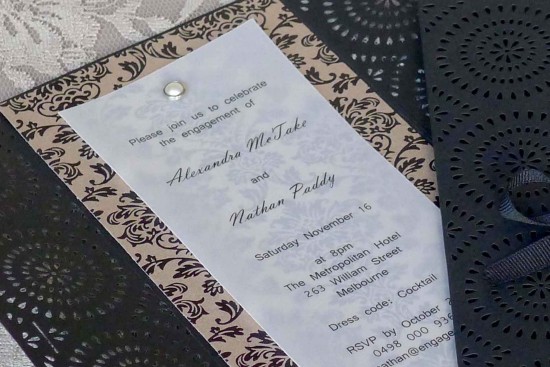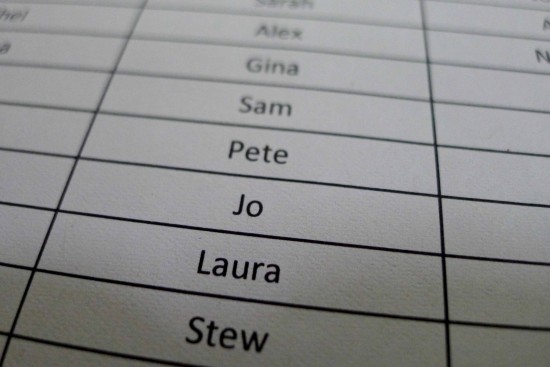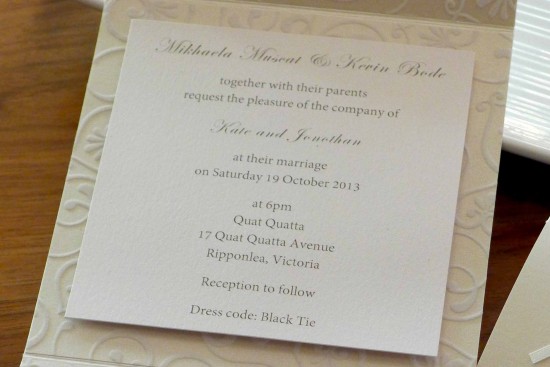Addressing your invitations can sometimes feel like a bit of a minefield. We don’t write many letters these days, so we have lost most of our knowledge of etiquette and usual practice. While there isn’t really a ‘wrong way’ to address an invitation, there are a few areas that are worth some thought, for example, whether you want to address your invitations formally or more informally.
Getting started
It always helps to start collecting your guests’ addresses early – not everyone will get back to you straight away and starting early will give you time to follow-up with the stragglers.
If your stationer is printing your guest names in the invitation or address labels for the envelopes, ask them if they have a template in which they would like you to enter your guests’ details. It will save you time to enter all your information straight into their template rather than having to re-enter all the information later on.
Invitations
You have the option of including your guests names on the invitation itself. Many couples like to do this as it makes it a more personal invitation for their guests. Alternatively, the invitation can include “you are invited to” or “please join us” to avoid including each guest name.
First name vs full name
First names only are usually listed on the invitation itself. Surnames can be added as well. On the invitation, the female of a couple is listed first.
Children
When including names on invitations, be specific – guests should take you literally if the adults’ names are listed and the children’s are not, as this indicates that they should not bring their kids along. By the same token, if you wish to invite children, be sure to include them on the invitation so that it is clear they are invited.
If you are worried your guests will not get the message, or if you have decided against including guest names on the invitation, you can still make it clear that children are not invited to your wedding. Adding a line such as “adults only please” is a tactful way to ask that parents do not bring their children along.
Envelopes
Decide how you are going to address the envelopes based on the level of formality of your event:
Singles are fairly straight forward and your options are:
Less Formal – Jane Smith
Very Formal – Mrs Jane Smith
Very Formal – Mrs Smith
Families are also easy, as you can address the envelope:
Family Smith
Couples
For couples, you have a few more options:
1. Traditional
eg: Mr and Mrs John Smith
This is an extremely traditional way to address invitations. This might be just the thing for your very traditional event, or you might want something a little more modern (or a little less sexist – this form of address paid tribute to the fact that a man ‘owned’ his wife!)
2. Modern
eg: Mr and Mrs Smith
This is a more modern and equal approach to addressing the envelope, but still retains formality in the address.
3. Simple
eg: John and Jane Smith
You can do away with titles entirely, and just keep it simple.
The lines are blurred when you have a married couple where the wife did not take the surname of her husband, or a de facto couple who do not have matching surnames. The easiest way to address this (no pun intended!) is to separate out their names entirely and you can then choose whether or not to add their titles, for example:
- Mr John Smith and Ms Jane Jones, or
- John Smith and Jane Jones
On envelopes, males are listed first.
Plus ones
If you are inviting a single guest to bring a ‘plus’ one, the envelope can be addressed to the single person, and include ‘and friend’ or ‘and guest’ on the invitation itself. If you are not including guest names on the invitations, add ‘and guest’ to the envelope instead.
Best of luck, and remember there is no ‘wrong way’ to address your invitation.
Photos by Be My Guest Invitations
![]()
Ms Gingham says: A nice, concise guide!
Toni Ossher of Be My Guest Invitations: As someone working in the science industry, I had to find an outlet for my creativity. My hobby over the last few years was to hand-make birthday cards for close family members. When I realised that I needed a career change, I decided to convert that hobby into a business.









Help…. it there a way to invite “Staff & Partner” when you only want permanent partners to attend, and not casual friends?
Hi Mara,
It’s best to address invitees by name.
If staff are important enough to invite to the wedding you’ll surely have some idea of whether they have a spouse or long term partner.
If you don’t know the partner’s name (but probably should) you can ask under the guide of checking spelling or surnames. Or at this time of year get an office admin to check for you under the guide of putting together a mailing list for festive greeting cards 😉
our invitations dont have our parent’s names on them
so would i just address it “mum & dad” / “nanna & pa” when writing the names on the invite?
Hi Stef,
Yes, address them as you would face to face (unless your wedding is super formal and you are comfortable using their proper names).
Go with your first instinct!